Site Menu:
| This is an archived Horseadvice.com Discussion. The parent article and menus are available on the navigation menu below: |
| HorseAdvice.com » Diseases of Horses » Endocrine System » Equine Metabolic SynDrOme and Insulin Resistance » |
| Discussion on What is with all this IR business? | |
| Author | Message |
| Member: stek |
Posted on Wednesday, Jan 28, 2009 - 4:50 pm: Not sure if this is the right place to post, I couldn't find a specific article on Insulin Resistance. If one exists, please point me to it.Here's what I'm after: I have been hearing more and more about horses being Insulin Resistant over the last year or so. While I don't doubt that this condition exists, I wonder why I haven't come across it in the last 20+ years, having worked with something close to 1000 different horses of many different breeds and with widely varied diets (though most being on good grass 12+ hours per day). Is it just that tests for it are only recently being developed, or the symptoms themselves are hard to pin down, or ? Part of it might be that I have spent most of my time at working farms where the horses are just generally kept fit. Those that run to fat are fed less and worked more, but overall weight management and what seem like the related IR symptoms are just not as much of an issue for the working and breeding horses I have known. When I started keeping my own backyard hobby-ponies and stopped working full time with horses I had some overfeeding/spoiling issues with my own horses, but basic diet changes and exercise took care of that. Is this something that affects mostly idle horses, or do horses in work get it too? Is there a set list of symptoms? Is IR caused by obesity, or is obesity caused by IR? Do all IR horses show hoof pain/founder issues? Are all IR horses overweight when not managed carefully? What else should I know about this? Now that the horses in my life are more pets working a couple times a week, I want to have a better understanding of this so I can avoid running into it. Thanks! |
| Member: scooter |
Posted on Wednesday, Jan 28, 2009 - 5:37 pm: Shannon you posted in the EMS article page, if you read the whole article it explains some of your questions.My opinion is it is caused mostly by over feeding and under exercising. I have posted before my vet calls it the the eats to much does nothing synDrOme and he is right for the most part. I think the easy keeping breeds are more prone to it (ponies, arabs, morgans..) My problem with it has been how little those non-working easy keeping horses actually need to survive and stay healthy. More and more horses have become pets and do not exercise as much as they should ...something I'm guilty of. When I had horses years ago I never had a fat one on the property and had to feed grain to keep weight on them...most of these were horse breeds and rode quite often. Do they all founder???USUALLY Not if it gets caught before it gets out of control (as Patty is doing). Some horses/ponies seem way more prone to it for some reason. I have seen a handful of ponies/horses be IR that are in work and not fat, these seem to be the ones that are hard to control. A cresty neck is usually a good indication of an IR horse. IMHO in MOST cases the problem begins with the owner over feeding and not keeping the horse exercised...2 things I am guilty of  I do believe I have the over feeding under control, but really wish I could exercise them more, which I think is imperative for these types. As long as you keep your horses at a good body weight I doubt you will run into the IR problem...cushings is another thing completely. Hope that helped a little 
|
| Member: jojo15 |
Posted on Wednesday, Jan 28, 2009 - 6:00 pm: mine came up that way 4 years ago? same scenario. we both turned into pudge balls when moving on our own.. and she just became a backyard pet. she is also 28 years old. She started to get the weepy eyes. and the pudgy neckline inherent for cushings. not losing her hair properly and quickly. and her feet were starting to tread that founder line...and was getting overly fat. Diagnosis IR.It took me one year and no more carbs. no more grain. and no more alfalfa. no treats. NOTHING. She gets hay only. 2-3 flakes a day. coastal swapping out with a T+A every few days. she is fine now. lost the weight. Sheds out nicely. and so on. yes its our management that does this to horses. |
| Member: dres |
Posted on Wednesday, Jan 28, 2009 - 6:00 pm: Shannon I am coming from the same school of thought as you.. but Diane explained what seems to be common since very well.. Fat is not good for beast or ME.. !~ I have had to keep my horses weight down becus of soundness issues, Now I am in a way glad I have , since I have not had to deal with the IR issues too..I glean so much from all of you.. thank you all for posting concerns and observations.. On the first day God created horses, on the second day he painted them with spots.. |
| Member: shirl |
Posted on Wednesday, Jan 28, 2009 - 6:23 pm: I've dealt with I.R. and out of control it's a nasty thing. Pockets above the eyes fill up, fat pads appear behind the shoulder muscle, above the tail head, etc. Neck is crested and hard. Ribs are difficult to find and there may be a "river" down the spine.The above comments are all true and good advice. NO sweets, no molasses, carrots, apples, etc. I learned a lot too late for my mare - she had bad legs/feet so was unable to be exercised a lot, but I kept the "goodies" coming. She also developed Cushings, another nasty thing. Exercise as much as you can and watch their diet and you'll do fine. Best of luck, Shirl |
| Member: kshayden |
Posted on Wednesday, Jan 28, 2009 - 6:39 pm: Better knowledge and care is keeping them around well into the late 20's and early 30's. 30 years ago, fewer horses lived as long.To me, Cushings is equivalent to diabetes in people - most get it when they are older and some are more prone when on the heavy side. Also a disease that in the last 30 years has become more common - folks are living longer too. Kathy (with Rosie, Cushings but not IR) |
| Member: scooter |
Posted on Wednesday, Jan 28, 2009 - 7:17 pm: Kathy I THINK IR and Cushings are 2 different entities, though a horse can have both, I have read an IR horse is more prone to cushings later in life...not sure if that is true or not.Cushings disease is USUALLY a disease of older horses with a tumor on their pituitary gland...I think. Nothing we can do about it but medicate For the most part I think IR or EMS is a man made problem and for the most part preventable... that is JMHO. 
|
| Moderator: DrO |
Posted on Thursday, Jan 29, 2009 - 10:03 am: Hello Shannon,What great questions and many we do not have a clear answer for. There are disease conditions and some medications that we know induce increased insulin resistance of the tissues of the body. Equine Cushings and somewhat related is the steroidal medications are examples of these. The reason EC and steroids are somewhat related is that the symptoms of EC are probably do to the release of steroid-like-behaving chemicals. Certainly as Karen points out above horses living longer and developing EC has increased the visibility of IR. The article has more on the symptoms of EC. However there is another problem we see in horses "Equine Metabolic SynDrOme". We call it a synDrOme because there is a constellation of recognizable signs and lab findings but the actual cause is unknown. The main lab finding is a higher than average level of glucose and insulin so they are therefore labelled insulin resistant. Diane's conjecture certainly would seem to apply to many horses I have seen over the years. This problem of obesity and easy keepers has been around for a while but 30 years ago these horses would have been labelled "hypothyroid". We now know hypothyroidism is very rare in the adult horse. I think what is clear is we have a poor understanding of what normal glucose and insulin levels are in the horse, how it might vary with breed, management, body condition, season, etc..., and what the effects of elevated levels might be. Certainly the work with founder is very interesting. We continue to update these articles frequently with new information and reviewing them carefully will certainly further help you with understanding further what we know and don't know about IR as a consequence of some diseases, and possibly a primary problem resulting in EMS. I think it is important to contemplate that 30,000 years ago IR might have been an asset to the horse as he would be able to maintain condition on fewer calories. DrO |
| Member: stek |
Posted on Thursday, Jan 29, 2009 - 11:27 am: Thanks guys and Dr. O for your insights. Very interesting. So if I have it right there are two types of IR: IR that is a side effect of other conditions (e.g. Cushings), and IR that is related to general obesity (cause/effect relationship not yet clear) .. ?What in the old days we may have called good old fashioned easy keepers are now sometimes being referred to as IR as we test for and try to work out what the normal levels of insulin and glucose are for the horse .. ? Now that you mention it Dr. O I have come across a few broodmares who were labeled hypothyroid and had the related problems conceiving. I wonder if they have been re-diagnosed now... One more question if you don't mind: I am told the test for IR is notoriously unreliable (I'm guessing due to the question of what's normal). If the symptoms of 'type 2 IR' for lack of a better name are the same as those for an easy keeper, and your horse tests negative, how do you know you have a horse that's IR and not just an easy keeper? Or is that THE question? And even if you had the answer, would it even matter as the treatment is the same? We have a little older arab mare who tends to fat and sheds out slowly in the summer (vet doesn't think she's cushingoid due to lack of additional symptoms). Would it be worthwhile to test for IR or are we good just treating her as an easy keeper? She has no general health problems (aside from the shedding thing and the odd sarcoid), has great feet, is very active etc. My gut says she's just a little chubbo arab, treat her accordingly and leave it at that. Thanks again for your input! |
| Member: scooter |
Posted on Thursday, Jan 29, 2009 - 3:36 pm: One observation I have made quite consistently through the years is the type Of fatty you own. I still can't quite figure the connection here.I haves seen/owned/boarded VERY VERY fat horses,(way fatter than Hank) the horses that are just fat through their guts (from shoulder to hip) have NEVER foundered. They don't get the cresty neck or weird fat pads. The horse that get the cresty neck and weird fat pads seem doomed to founder or at the very least very prone to multiple problems. SOOOO why do some horse get cresty necks and others don't???? Even tho they are just as fat or fatter than the horse WITH the cresty neck? Is it like I read about people...If they carry their fat in their stomach they are more prone to problems then people who are hippy?...I wonder what the research is behind that? Just from my observations if you have a horse that is developing a cresty neck...get their weight under control and exercise them! Here's an example of what I'm talking about... the first horse is my friends she kept him here for a year, he was fed the same as Hank. Hank is a bigger horse, this guy was a pony..13.3hh. Even my vet said he was way fatter than Hank...yet take notice he has NO cresty neck and not much for fat pads. The picture of Hank is at the same time, he wasn't as fat as the pony, but notice the cresty neck...he is VERY prone to founder, the pony had hooves of steel and could eat grass all day....so what's the difference? Sam the fat pony and believe me he was much fatter than he looks in this pic 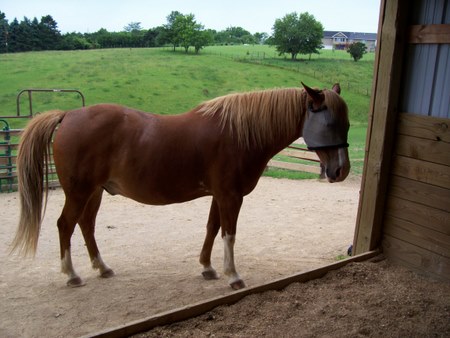 Hank with his cresty neck, can't eat grass, and wasn't as fat as the pony IMO. and my vets 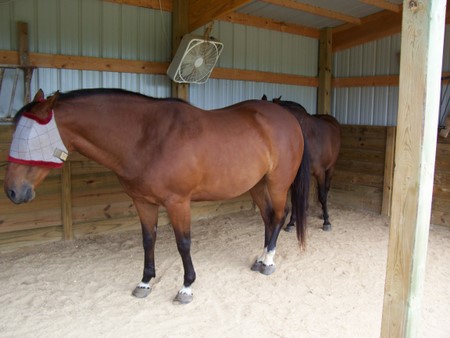
|
| Member: dres |
Posted on Thursday, Jan 29, 2009 - 4:20 pm: I don't know Diane , its a toss up.. them are some beefy horses.. !! Hard to tell by the pictures of cresty neck with the mane down.. but I do understand what you are talking about.. I think it interesting topic .. My gelding that i keep the weight off could have a cresty neck , its the way he is built.. the picture in my profile.. AND he does have hoof issues all tho not due to being heavy or otherwise.. just plain old bad luck..like your observations tho.. What is the footing in the shelter.? On the first day God created horses, on the second day he painted them with spots.. |
| Member: stek |
Posted on Thursday, Jan 29, 2009 - 4:37 pm: Hmmm, I know what you mean about the cresty neck vs big belly thing, the arab mare I mention above only gets a hay belly, never gets a cresty neck or fat anywhere else. We do try to manage her weight though. The horses that I have known with a tendency to get cresty also had a tendency to founder. This was back when we just called them 'fat' though Also some horses put weight on all over .. like my own arab. He might develop a wee bit of a crest but really puts on an almost even layer of subcutaneous fat and has never had founder issues. When at his fattest I remember looking at him from up in the hayloft and seeing dimples all over his back and rear. Talk about a wake-up call! I am including a photo of him from his fatter days below.. 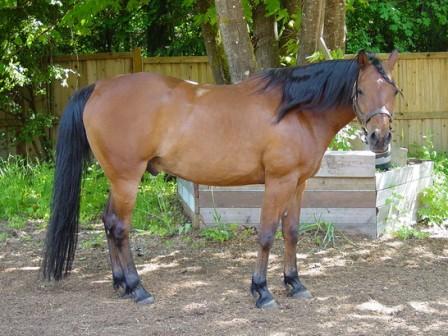
|
| Member: scooter |
Posted on Thursday, Jan 29, 2009 - 5:05 pm: Just so Dr.O. don't yell at me I'm not saying horses with out crests don't founder. I'm not saying horses with out crests don't founder. I'm trying to say that horses with crests seem way more prone to founder and wonder if the cresty neck/weird fat pads is somehow linked to IR. The ones I have observed without the crests seem to tolerate "sugars" better. Here's a little better pic of Sam the fat pony...his neck was straight as can be, he was 14 yo. in that pic and very fat as long as I can remember. He is ridden about 2 times a year...so no exercise. Hank even in good weight..my other 2 also, always have some sort of crest. 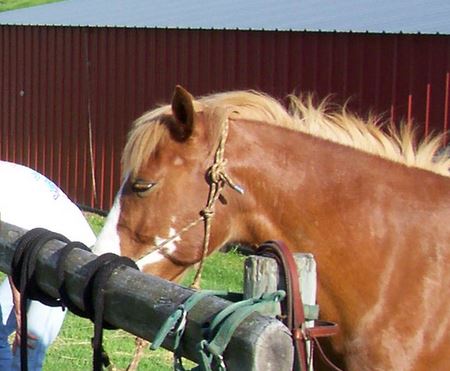 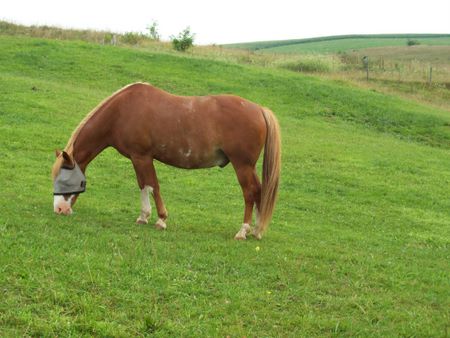 Hank in good weight...but still has that crest. He was licking the wall because he was hungry LOL. 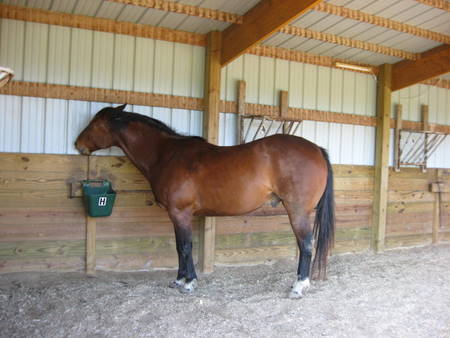 Ann the footing in my lean to is crushed limestone |
| Member: scooter |
Posted on Thursday, Jan 29, 2009 - 6:14 pm: so here is the theory on humans/mice .... I wonder if the type of fat makes a difference in horses too? Personally I think so . . I just wonder what makes the fat decide where to go?? https://www.foxnews.com/story/0,2933,477434,00.html |
| Member: scooter |
Posted on Thursday, Jan 29, 2009 - 6:25 pm: OK so the link wouldn't work so here is the story...interesting. so here is the story...interesting. Having a Big Derriere May Be Good for Your Health, Study Finds Wednesday, January 07, 2009 | FoxNews.com Women can stop worrying about pear-shaped figures — fat bottoms have been scientifically proven to be a sign of good health. New research, published in the journal Cell Metabolism, suggests the fat responsible for producing the pear shape flaunted by celebrities such as Jennifer Lopez and Beyonce may be active in protecting women from diseases by releasing certain hormones. Buttock and hip fat may protect women against type 2 diabetes, researchers from Harvard Medical School found. When buttocks and hip fat from mice was injected into other mice, their bodies easily used the blood sugar-regulating hormone insulin and lost weight. They were also able to make better use of insulin, the main hormone linked to diabetes. People with the apple shape, where fat is stored around the tummy, can be more prone to type 2 diabetes and heart disease. Those with pear-shaped bodies, where fat is collected in the buttocks, are less likely to have these disorders. Researcher Dr. Ronald Kahn insisted that not all fat was bad for health. "The surprising thing was that it wasn't where the fat was located, it was the kind of fat that was the most important variable," he said. "Even more surprising, it wasn't that abdominal fat was exerting negative effects, but that subcutaneous fat was producing a good effect. I think it's an important result because not only does it say that not all fat is bad, but I think it points to a special aspect of fat where we need to do more research." Scientists also monitored the health of the mice given the fat transplants. When it was inserted into the tummy area, the mice lost weight and their fat cells shrank. The researchers will now try to identify the hormones. |
| Member: mrose |
Posted on Thursday, Jan 29, 2009 - 7:37 pm: Sometimes a horse will have a big tummy, but isn't really fat, even though the horse will look fat at first glance. If a horse is eating a lot of grass or hay, but for whatever reason isn't able to get enough nurishment from what it is eating, it will remain thin on top but still have a big belly. When switched over to cubes, these horses will often do really good and will look a lot better and better, more evenly filled out. At least that's been my observation. |
| Member: scooter |
Posted on Friday, Jan 30, 2009 - 6:09 am: Yes I have seen the "hay belly" and don't really consider that "fat" The pony above was FAT no hay belly there . I wish I had other pictures of the fat horses I had that were very fat with no crest, I always have wondered why some fatties develop crests and others don't,, and they don't seem so sensitive to "sugars" As you can see Sam was eating nice, lush, spring grass. He never had a DP the whole time while eating that 24/7 and has never had laminitis. Hanks coffin bone would go through his sole if he ate that grass 24/7 or even a couple hours? . I wish I had other pictures of the fat horses I had that were very fat with no crest, I always have wondered why some fatties develop crests and others don't,, and they don't seem so sensitive to "sugars" As you can see Sam was eating nice, lush, spring grass. He never had a DP the whole time while eating that 24/7 and has never had laminitis. Hanks coffin bone would go through his sole if he ate that grass 24/7 or even a couple hours?
|
| Moderator: DrO |
Posted on Friday, Jan 30, 2009 - 9:09 am: Shannon, though the answer to your question might hold real interest to a scientist, to the horse owner there is very little difference in how you might treat the two: reduce the caloric intake of the horse. With the IR keeper there should be a real attempt to concentrate on starches and NSC in forages but for the majority of horse diets the changes would look very similar: removing grain products and switching out to less nutritional hays.DrO |
| Member: stek |
Posted on Friday, Jan 30, 2009 - 4:32 pm: That makes sense Dr. O, thanks. I will just keep on how we have been: diet and exercise.Diane, love the article .. what makes the fat decide where to go .. must be smart fat, now that's a concept. If that's possible then I am carrying around several extra pounds of brilliance  Sara that's interesting about the cubes versus loose hay. Do you think that's because of feeding a decreased amount, or more processed 'pre-chewed' cubes or ? |
| Member: mrose |
Posted on Friday, Jan 30, 2009 - 11:03 pm: Shannon, this mare has always had a big "hay belly" even when getting exercised. I had a vague recolection of reading somewhere that feeing cubes would reduce the size of the hay belly, so thought I'd try it. I think I've also read that some horses can't get enough nutrients out of hay so eat more of it and get a "hay belly." In my mare's case, she is getting the same amount in pounds of cubes as she did in pounds of hay. Our hay is good quality and she was getting a grass/alfalfa mix hay and is getting a grass/alfalfa mix cube. So, I'm not real sure of the difference except the difference in "space" between the cubes and hay. I would assume the hay in the cubes, once chewed and moistened with saliva and secretions would expand to take up the same amount of room as the equal poundage of hay, but why it doesn't make the stomach expand as much, I'm not sure. It has really made a difference in how she looks however. Maybe someone else has a good esplanation? |
| Moderator: DrO |
Posted on Saturday, Jan 31, 2009 - 8:34 am: A hay belly should not be considered when assessing a horses condition as both thin and fat horses can have one. To properly assess the horses condition see Horse Care » Routine Horse Care » Estimating Weight, Height, and Body Condition Scoring.DrO |
| Member: mrose |
Posted on Saturday, Jan 31, 2009 - 9:03 am: Why would feeding cubes make a difference in a hay belly? This mare is in pretty good shape other then her belly, which is now much better than it was, for which I'm glad, but am curious. Everything else is the same as far as her feed and exercise routine goes. |
| Member: ajudson1 |
Posted on Saturday, Jan 31, 2009 - 10:41 am: My older mare, Arab, who is 20 now, has always developed a hay belly over the winter, and always had a very slow shedding time in the spring. As she's aged, (I've had her since she was 2)she gets some fat over the winter along with the hay belly.Maybe Sara or someone with Arabs can answer this question: Do all Arabs have like a downy undercoat that don't shed as fast? That is the part of her that don't shed out. It's soft and dense. Her longer outer hair does shed out, but I need to clip her to get rid of the furry black hair. I've never noticed it in other horses, Arab or otherwise. It seems their hair all sheds out equally. How does that work into the equation if she's IR, or has thyroid problems. As far as I know, she is healthy except for the issue of needing Selenium, and maybe this spring she will shed different with SE in her daily diet now. I bring this up because slow to shed out in the spring I am taking to mean all of their hair, not just the undercoat? Another note, it's her neck & chest that has the hair the longest. And grooming don't bring much out, least you're thinking I just forget to brush her there. |
| Member: warthog |
Posted on Saturday, Jan 31, 2009 - 11:29 am: we own a mare we bought at 17. she had a prominent crest and fat pads. we didn't know it at the time but she had foundered repeatedly for her former own. we've always had her on mix grass, weed, unfertilized pasture and fed a high protein high fat, small amount of grain. little by little she lost the crest and fat pads to the point where you can feel them but now see them and she has not foundered in the nine years we have owned her. we switched her to straight alfalfa because of allergies and she has gotten fairly fat but her crest and fat pads have not enlarged, nor has she foundered. she gets 1.25 pounds of beet pulp based low carb, high fat high protein feed per day. so it is possible to keep them from foundering if you have really bad pastures or drylot because she did not founder on unlimited grass hay either - tifton 44 rolls to be precise. her former owner had lush, fertilized green grass pastures, fed several scoops of an expensive brand of sweet feed (it was really sweet) and as I mentioned, she foundered multiple times at his farm.so I'd surely dry lot a cresty horse with fat pads if you don't have "bad pasture" and go with beet pulp or alfalfa and low carb, low qualtities of grain. we look for the really coase round rolls for her and never had a problem with them either. all you can do is experiement. all our guys are super fat right now because of a hay shortage and our switching to alfalfa and so far no founders from all 14 including the founder prone old mare so I guess fat on alfalfa doesn't seem to cause the problems that "fat on green grass" does. but be careful. It just might we we've been lucky to get low sugar, low carb hay because of the way our hay processors harvest??? |
| Member: stek |
Posted on Saturday, Jan 31, 2009 - 12:59 pm: Angie, the mare I mention above is also 20, slow to shed completely (though she does partially) and prone to the hay belly. My other arab who is about 15 gets quite furry in the winter but sheds out slick and clean and gets fat all over. Not a representative sample of the breed but does show two polar opposites... |
| Member: scooter |
Posted on Saturday, Jan 31, 2009 - 5:28 pm: My arab gelding (22) doesn't shed completely either. He sheds everything but his undercoat too...which is quite thick and I end up clipping.Last year he was in very good weight come spring, even a little ribby. He has the weirdest fat pads all over his body, they even run down his thigh in lumps. They did shrink when he was a little thin, but never went away. My vet said last year he bet he would shed completely out since I had gotten his weight under control....he didn't! BUT he did seem to shed quite a bit more than he has in the last 5 years. |
| Moderator: DrO |
Posted on Sunday, Feb 1, 2009 - 12:09 am: Whether forage is fed as cubes or not will not make a difference if it true that everything else is the same including the forage quality.DrO |
| Member: mrose |
Posted on Sunday, Feb 1, 2009 - 10:52 am: I don't know how to explain the change in this mare's belly then; it has gone down quite a bit and nothing else has changed. All our other horses get fat as little pigs on the hay, with the weight spread evenly around their bodies, so I assume the quality is good. I have to really watch how much I feed them.Arabs and hair: yes, I think all Arabians kept in a cold climate get that soft undercoat. They look like fluffy little teddy bears. When they start shedding, I look like a fluffy little teddy bear! 
|
is The Horseman's Advisor
Helping Thousands of Equestrians, Farriers, and Veterinarians Every Day
All rights reserved, © 1997 -
